Illustrated Catastrophes: A Kaleidoscope of Code Catastrophes
All references are based on the 2014 edition of the NEC.
A Kaleidoscope of Code Catastrophes
There are so many violations here that I’m not sure where to begin. I suppose I will start by pointing out the lack of working space in front of this panelboard, as required by
Sec. 110.26. The lawn mower, volleyball net, chairs, and poles can be moved out of the way, but they still create a violation of 110.26(B), which requires this working space to be kept clear and not used for storage. The water pipe, however, is a permanent obstacle and cannot be simply moved out of the way. Sections 110.26(A)(1),(2), and (3) require the working space in front of this panelboard to be kept clear for a minimum of 3 ft of depth, 30 in. of width, and 6½ ft of height, respectively. The next problem I see is the receptacle boxes dangling off the end of the NM cables. Supporting boxes in this manner can really put a strain on the conductors — greatly increasing the risk of a short circuit from damage. Section 314.23(H)(1) permits using flexible cords or cables with strain-relief type connectors in a manner that protects the conductors against strain and damage. Using NM connectors to support the box in this manner is a violation of Sec. 110.3(B).
Shining a Light on Violations
These PV source conductors are permitted to be single conductor type USE-2 or listed PV wire in accordance with Sec. 90.31(C)(1). I do question the use of those cable ties in this outdoor sun-drenched application though. Section 300.6(C)(1) requires nonmetallic supports and support hardware, such as these cable ties, to be identified or listed as being sunlight resistant where they are installed in areas exposed to direct sunlight like this rooftop location. If they are not sunlight resistant they will become brittle and will eventually break and fail. Section 690.31(G)(3) requires wiring methods and enclosures such as the PVC box installed here to be marked with the wording “WARNING: PHOTOVOLTAIC POWER SOURCE.” The markings on the box cover must be visible after installation and are specifically required to be reflective (with all letters capitalized) and a minimum letter height of 3/8 in. in white on a red background in accordance with Sec. 690.31(G)(4). These markings assist emergency personnel in locating these energized wires in and on
buildings. Another problem may be the way the wires enter this box through a LFNC connector used as a sleeve since Sec. 314.17 generally requires the wiring methods to be secured to the box.
About the Author

Russ LeBlanc
Owner
Russ started in the electrical trade as an apprentice in 1985. He worked his way up to become a Journeyman Electrician and then eventually became a Master Electrician and Licensed Construction Supervisor. In 1999 Russ become an Electrical Instructor for The Peterson School of Engineering in Massachusetts where he developed his passion for teaching, and quickly became Department Head of Electrical Instruction. Russ has taught thousands of apprentices, electricians, engineers, inspectors, and other electrical professionals during his career as an instructor. He continues to provide electrical professionals with Electrical Code seminars, Arc-Flash Awareness training seminars and educational material through his LeBlanc Consulting Services in North Reading, MA whose specialty is educating electricians. He has been an active member of the NFPA Electrical Section and has authored hundreds of National Electrical Code proposals and comments which have become Code rules to improve the safety for the electrical industry. Russ is also an IAEI certified Electrical Inspector.
Please visit www.russleblanc.net for more information.


